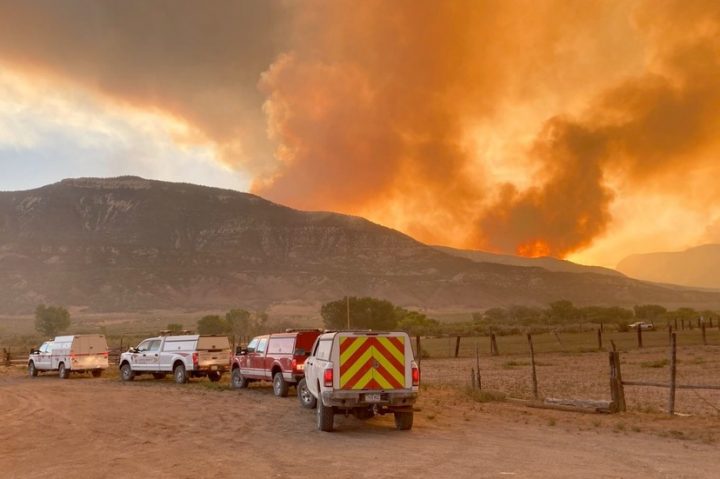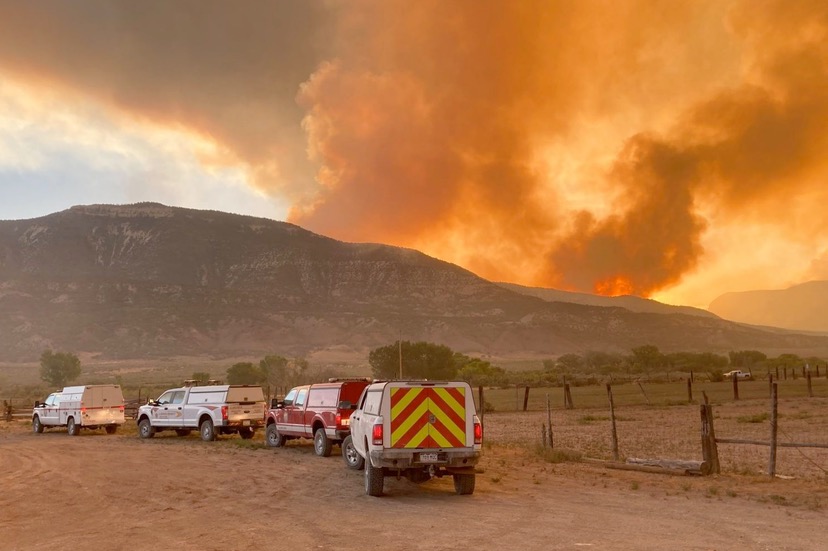This article is excerpted from the original August 12 story by reporters Chase Woodruff, which you can read on ColordoNewsline.com
A pair of major wildfires on Colorado’s Western Slope have spread rapidly in recent days and are expected to continue to grow on Wednesday amid extremely hot, dry and windy conditions.
Located about 50 miles apart, the Pine Gulch Fire and the Grizzly Creek Fire have both been supercharged by the severe drought conditions that have gripped Colorado this summer, officials say, and rough terrain has made them difficult for firefighters to suppress.
“It’s a combination of everything coming together,” said Larry Helmerick, fire information coordinator for the Rocky Mountain Area Coordination Center. “We have dry, receptive fuels, low (relative humidity) all over western Colorado and Wyoming. Low humidity, hot temperatures, wind conditions and dry fuels — all those combine to give us extreme fire behavior, and if there’s fire in the area, it’s going to be extreme, like what we’re witnessing on Grizzly Creek and Pine Gulch.”

The Pine Gulch Fire, located about 15 miles north of Grand Junction and caused by a lightning strike on July 31, had grown to an estimated 51,455 acres as of Wednesday morning, according to the Bureau of Land Management. At least 658 personnel are battling the blaze, which has forced evacuations along several roads in the sparsely-populated Roan Cliffs area.
Already, the Pine Gulch Fire ranks as the 7th largest wildfire in Colorado history, and the blaze is currently estimated to be only 7% contained. It has roughly doubled in size in just 48 hours amid hot, dry weather and high winds — and those conditions aren’t expected to improve anytime soon.
While smaller, the Grizzly Creek Fire has proved more disruptive than Pine Gulch since it ignited along Interstate 70 near Glenwood Springs on Aug. 10. Two days later, Colorado’s primary east-west interstate remains closed in both directions between Glenwood Springs and Gypsum, with no timetable for reopening.
The community of No Name, located along the fire’s western edge, was evacuated Tuesday. As it grew rapidly throughout the afternoon, the fire jumped I-70 and the Colorado River, forcing additional evacuation orders to be issued for the Lookout Mountain and Coulter Creek areas.
“We had a couple of spot fires come from the north side over to the south side,” said Beau Kidd, of the Rocky Mountain Incident Management Team, a federal interagency firefighting group. “Fuels and slope lines, with a little bit of wind, made a rapid movement up the south side of the river.”
Like its neighbor to the west, the Grizzly Creek Fire was expected to grow rapidly, given hot, dry and windy conditions on Wednesday.
“The fire is expected to be extremely active and fast-moving,” officials wrote in a press release.
Water restrictions have been put in place in Glenwood Springs after the city shut off a water source from No Name Creek due to firefighting operations.
“This is out of an abundance of caution to protect the water supply from fire retardant being used on the Grizzly Creek Fire in Glenwood Canyon,” city officials said in a press release. “The City has notified large water users in the area and restricted consumption and residents are encouraged to conserve water used for irrigation.”
Firefighters on Wednesday planned to focus their efforts on assessing and protecting homes and other structures that may be in the fire’s path in the more densely populated areas to the south.

